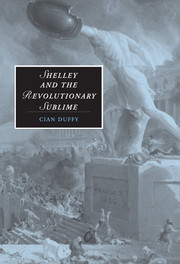Book contents
- Frontmatter
- Contents
- Acknowledgements
- Note on texts
- List of abbreviations
- Introduction: Approaching the ‘Shelleyan sublime’
- 1 From religion to revolution, 1810–1813
- 2 Cultivating the imagination, 1813–1815
- 3 Mont Blanc and the Alps, 1816
- 4 Writing the revolution: Laon and Cythna (1817)
- 5 ‘Choose reform or civil war’, 1818–1819
- Conclusion: ‘Good and the means of good’, 1822
- Notes
- Bibliography
- Index
- CAMBRIDGE STUDIES IN ROMANTICISM
3 - Mont Blanc and the Alps, 1816
Published online by Cambridge University Press: 15 December 2009
- Frontmatter
- Contents
- Acknowledgements
- Note on texts
- List of abbreviations
- Introduction: Approaching the ‘Shelleyan sublime’
- 1 From religion to revolution, 1810–1813
- 2 Cultivating the imagination, 1813–1815
- 3 Mont Blanc and the Alps, 1816
- 4 Writing the revolution: Laon and Cythna (1817)
- 5 ‘Choose reform or civil war’, 1818–1819
- Conclusion: ‘Good and the means of good’, 1822
- Notes
- Bibliography
- Index
- CAMBRIDGE STUDIES IN ROMANTICISM
Summary
On 3 May 1816, Shelley, Mary, and Claire sailed out of Dover en route to Switzerland for a second time. Financial and personal motives lay behind the trip. After months of financial wrangling, Shelley certainly wanted to leave London. It seems that his choice of Switzerland was influenced at least in part by Claire's desire to follow Byron, with whom she had been involved for some weeks (Byron had already left for Switzerland on 23 April, following the receipt of his separation papers). The Shelley party would spend the next three months – in the company of Byron – amidst ‘scenery of wonderful su{blimity}’ on the shores of Lake Geneva (Letters, i, p. 475). Shelley and Byron would spend a week sailing around the lake together, visiting Chillon, Lausanne, Meillerie, and Clarens. And shortly before their return to England in August, Shelley, Mary, and Claire would visit the ‘famous valley’ of Chamonix and see, ‘towering far above, in the midst of its snowy Alps, the majestic Mont Blanc’ itself (Letters, i, p. 494; H6WT, p. 94).
Shelley's initial reaction to this ‘magnificent valley’ was ‘astonishment’ and ‘dizzying wonder’ (Letters, i, pp. 494, 495, 500). He told Byron that Chamonix ‘exceeds and renders insignificant all that [he] had seen before’ (Letters, i, p. 494). To Peacock he described ‘mountains whose immensity staggers the imagination’ (Letters, i, p. 496).
- Type
- Chapter
- Information
- Shelley and the Revolutionary Sublime , pp. 84 - 122Publisher: Cambridge University PressPrint publication year: 2005

